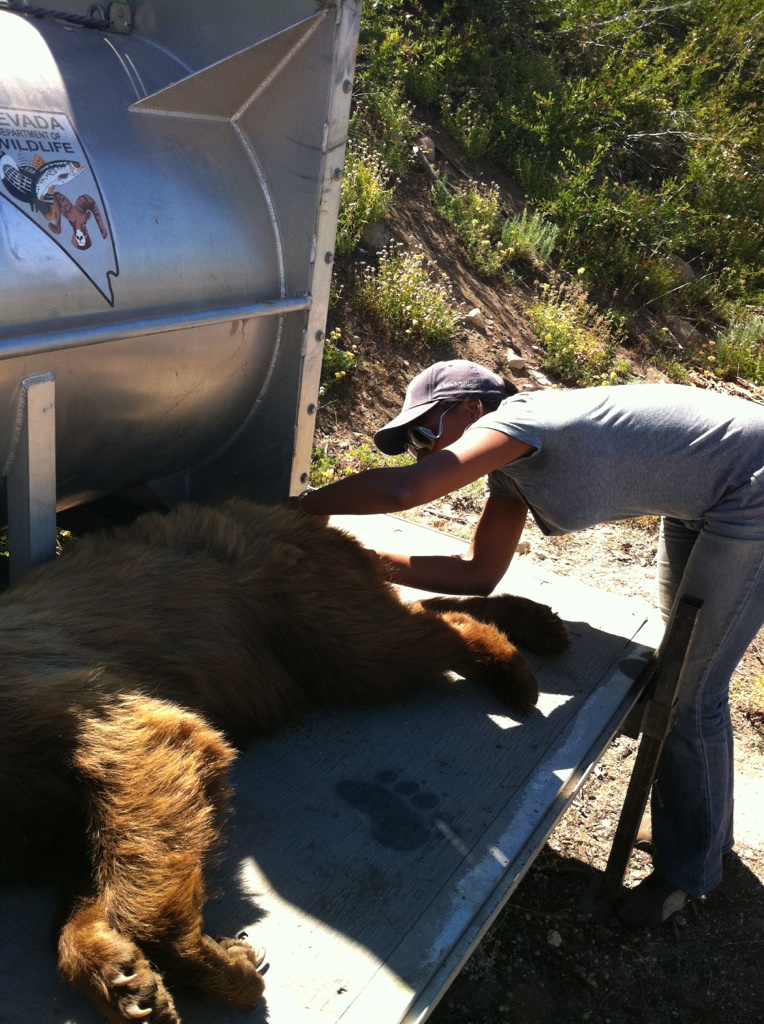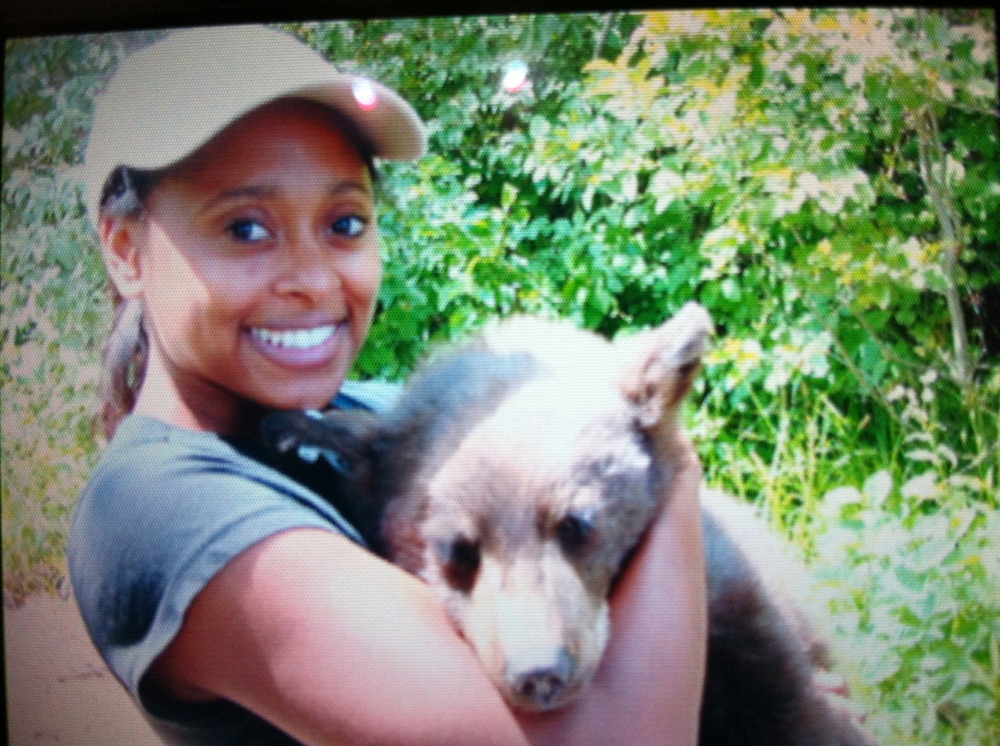300 lbs. of Cinnamon
I started writing this dispatch at my good friend Anita’s house. I live in a “low-lying area” (between a creek and a river) that was evacuated so Hurricane Irene could take over the space in a more expansive manner. Anita is a librarian and manager of her branch. Her house–just across town–hasn’t lost electrical power in almost a decade’s worth of big storms. She is the Emergency Contact of My Dreams.
Anita’s wisenheimer (but mainly smart and fabulous) son sent her this email after reading my August 8 post about Rae’s field work with Ursus americanus:
Ma,
I didn't tell you about my plans for this weekend? I'm planning to go swimming with Great White Sharks in the Great Barrier Reef while wearing a wet-suit made out of raw, freshly cut t-bone steaks. I was thinking about poking a wasp nest with my finger and sleeping on a mattress full of bedbugs first, though...
What do you think?
Nick
Capture 1
“I was thrilled!”
On Rae’s dad’s birthday, the person whose turn it was to check the traps called Carl, then Carl called Rae to tell her they had a bear. The trap was in a remote area at the top of a mountain all the way up a little winding dirt road. Forest service and fish and wildlife personnel access only.
“It was awesome.”
Cinnamon (not her real name) had taken the bait: cookies with M&Ms from the grocery store. Most black bears are black or a very dark brown. But like people and other colorful animals (flamingoes!), black bears vary in color. Cinnamon is a cinnamon-colored black bear. Her cubs are black. Cinnamon’s real name is the secret agent-sounding Green 99. All bears in the study are named with a color–for the region they occupy–and a number. Except for the first 20 bears at the study’s outset in 2001. Carl and Jon named those bears after their favorite players from the Denver Broncos. (Shoutout to Trevor, Brian, Ed, Rod, and the crew. Raise a paw if you’re with me!)
Cinnamon’s three cute little cubs watched the action from a nearby tree. Unsurprisingly, Cinnamon was through, and was making a lot of noise in the trap. I ask Rae how bears sound. (In children’s stories they speak like humans.) She says they growl and kind of bark.
To recap, we have mama bear in a trap, growling and barking, with her cubs up a tree. “Bears are never very good when you separate them from their babies, “ she tells me. I think, Who is? But I don’t know if I say this to Rae.
This is how it goes once the bear is in the trap:
1) Stick the tranquilizer gun through the bars at the entrance to the trap, and shoot into the bear’s shoulder area from a close position.
2) The bear falls over. (The tranq dart knocks the bear out for about two hours.)
3) Open the door.
4) Everybody pulls the bear out of the trap. (What must this be like?)
5) Put/carry the bear to somewhere shady and flat.
6) Take her/his stats.
7) If it’s a sow and she has cubs nearby, tranquilize them, if possible, to measure, weigh, and tag them.*
This is a photo of Rae taking Cinnamon’s temp with a rectal thermometer. Cinnamon was at 99.5 degrees; a little low, but healthy. Carl handed Rae the thermometer, “OK, it’s your first time on a bear.” The rectal part was Carl’s version of a surprise.
Rae had her tranquilizer gun moment two days later with Green 68. [Note: Green 68 was lured by pie. Luke, a wildlife biology student intern with the Nevada Department of Wildlife, is tasked with shopping for sweets for the traps. He seems to bring enthusiasm to this part of his job.] Green 68 filled up the entire trap. Rae, a novice, couldn’t miss. The tranq dart is propelled by carbon dioxide, and makes a sound like air moving very fast (ssssshooop). “You know like in the movies the assassins have those guns that place a red dot on the target? It’s just like that,” Rae says. Maybe one day she will have her own nature show where she can choose her wardrobe. (A dream come true, fingers crossed.)
*About the tagging:
1) Carl’s and Jon’s and Rae’s study is out of collars. The collars cost about $5,000 each, and right now they’re in search of money. So, instead…
2) The bears get tattooed. In a monitoring procedure called “mark recapture,” the captured bears are tattooed on the inside of their lip and a tag is affixed to one of their ears. The ear tags “are like insurance,” Rae says. Just pick up a pair of binoculars, read the tag from far away, and record the bear’s location. In the event the tag comes off, the bear still has the tat. This way the bears don’t have to be tranquilized so often for the team to keep track of them.
3) I'm feeling bad about the tattooing. Rae says environmental biologists can’t catch a wild animal and not keep track of it. “The bear is unconscious; you lift up its lip and write,” she says firmly. (I am reminded of when we visited a little farm when she was in kindergarten, and she bottle fed the cutest fuzzy black lamb. I asked the farmer how long she kept the lambs. “Oh, not very long. They become lamb chops,” she laughed. “I love lamb chops,” small Rae exclaimed, holding the bottle to the little lamb’s lips without wavering.)
4) The team keeps track of the number of times their bears are captured. If they capture a lot of bears, and many are first timers, they know there’s a large population.
5) Reminder: the point is to find out where the bears are and what kinds of habitats they’re using in order to, eventually, prevent destructive human-wildlife interaction. (Please see August 8 post.)
Capture 2
Here’s Rae’s recounting of Green 68’s capture:
Green 68 had two cubs that gave us a run for our money. She was in the trap and the cubs were around the trap waiting for her. You have to be really quiet. They’re so little and fast they just zoom by you. There’s such dense vegetation, we couldn’t catch them. We all hid and waited. We tranquilized mom and took her out of the trap to a shady spot on the ground. The cubs came back to their mom in about 30 minutes’ time. Then they started nursing while she was unconscious. They’re about 6 months old. It was easy to shoot them. Carl did it.
Here's Rae and one of Green 68's offspring while it was spaced out. Completely sweet.
Both mama bears had already been tattooed before their August recapture.
Final shoutout of this post goes to Oba, Rae’s boyfriend in NYC who had their new apartment all ready when she got back, and found the rectal thermometer factoid TMI. This was his maiden voyage as a wildlife ecologist's urban life partner. If he was freaking out, he did it away from his Blackberry.
BTW, the Ray May Fire in NV (mentioned in my last post) was contained in 3-4 days. Hurricane Irene did an excellent job on the Great Dismal Swamp fire, which must be the primary reason she rolled through this part of VA.
Text your mother photos of you with wild animals, remembering to indicate that they’re unconscious and you are not.


